Purple dead nettle (Lamium purpureum) is an easily foraged edible plant that is likely growing in your backyard or nearby. Often considered a common “weed,” it has been traditionally used for both culinary and medicinal purposes, making it a good foraging opportunity this spring!
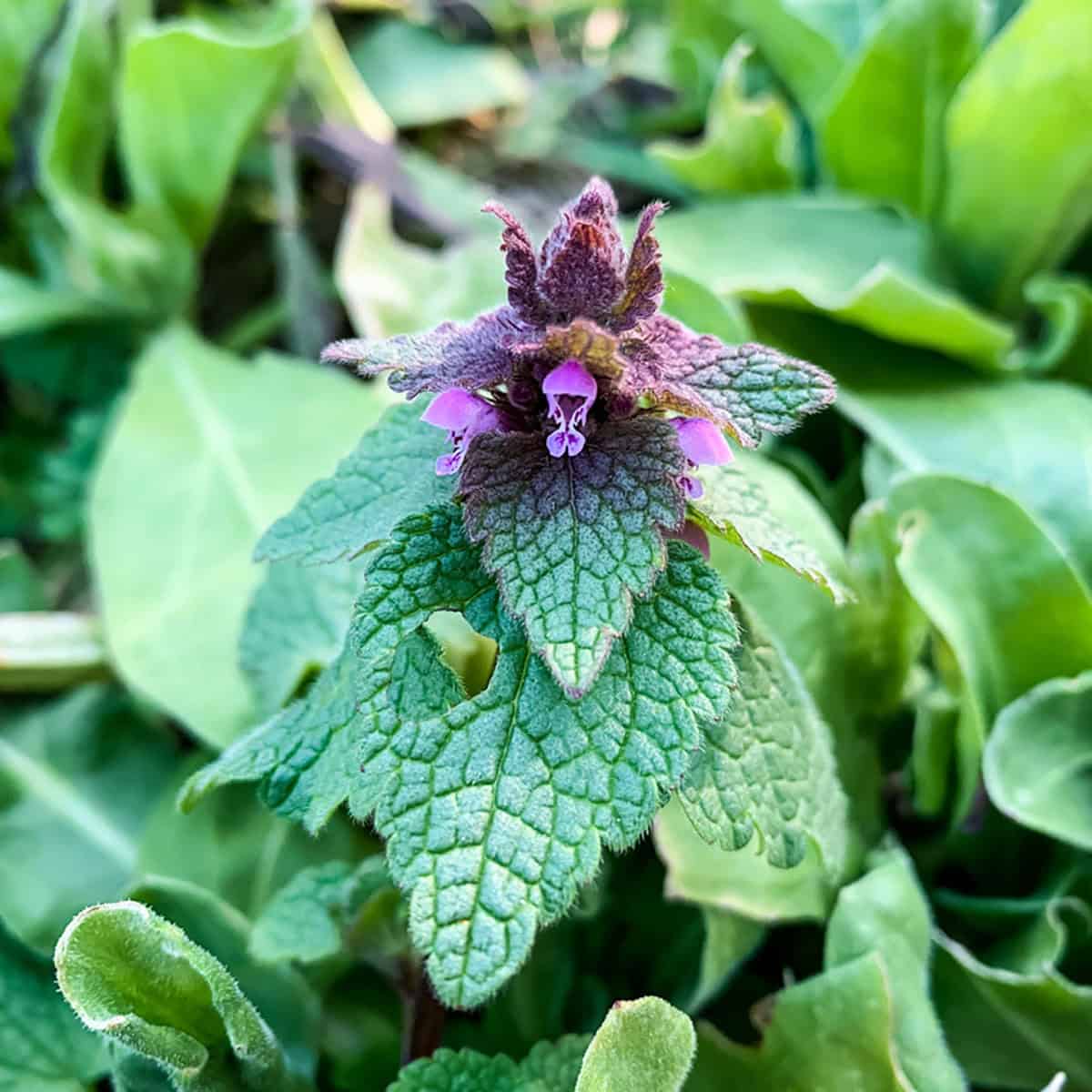
Want to save this post for later?
Wildcrafting Weeds
If you want to learn more about the edible and medicinal weeds that surround us and how to use them, check out my eBook: Wildcrafting Weeds: 20 Easy to Forage Edible and Medicinal Plants (that might be growing in your backyard)!
Foraging Purple Dead Nettle
Because of its widespread nature, foraging for purple dead nettle (Lamium purpureum) is usually pretty easy.
It is native to Europe and Asia, but has become commonplace in North American gardens and disturbed areas.
I can almost guarantee that you’ve seen purple dead nettle growing at one time or another.
You may not have realized it, as it can sometimes be fairly inconspicuous, but if you really start to pay attention to the plants around you, I’m certain that you will see it growing.
Related: What to Forage in Spring: 20 Edible and Medicinal Plants and Fungi
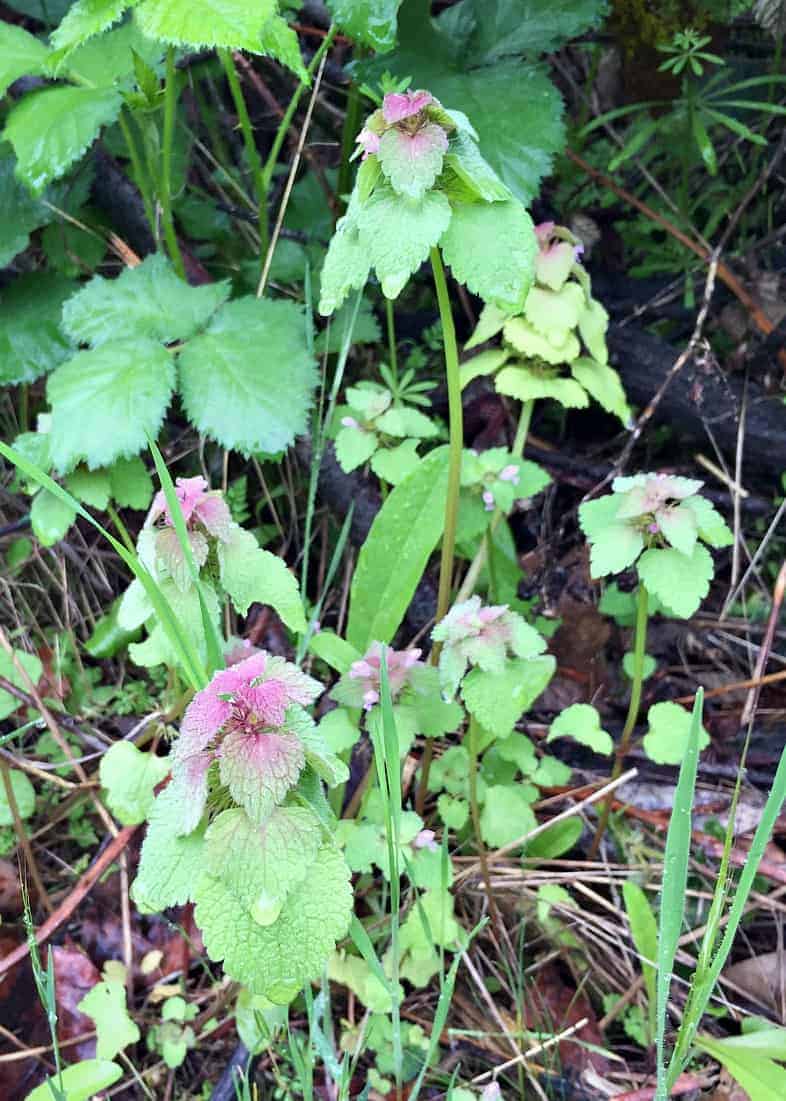
Purple dead nettle is one of those plants that when you see a picture of it, you immediately recognize it, but never knew what it was called.
This is how I was with plantain – I’d seen it my entire childhood, and up until I was almost 30 years old, before I had any idea of what it actually was!
I was happy to discover its benefits, just as I was with purple dead nettle.
It sometimes grows in huge patches, which can be annoying if that patch happens to be your garden, but it does make collecting it easier!
I have a good bit of it growing in my backyard, and I see it everywhere when I’m out on walks. I finally decided to look it up to see what it was, and was happy to find out that it’s edible and medicinal!
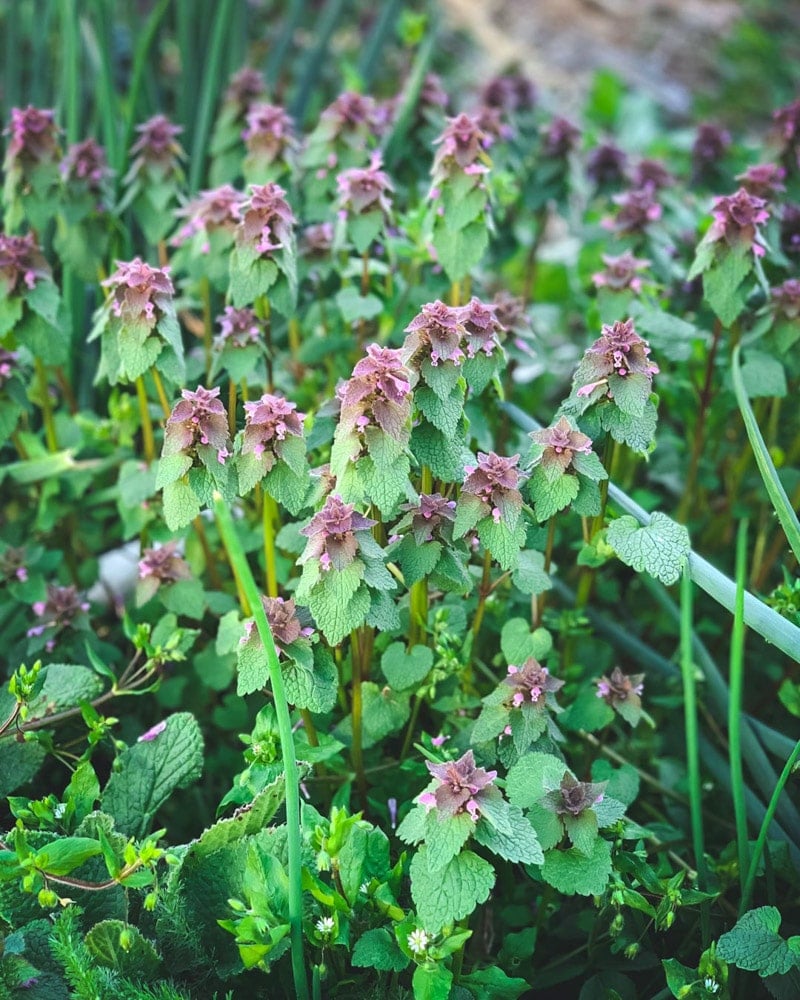
Identifying Purple Dead Nettle
Purple dead nettle is in the mint family, and is called “dead nettle” (or sometimes “deadnettle”) because of its apparent resemblance to stinging nettle, minus the sting.
This confuses me somewhat, because I don’t think it really looks like true nettles at all, but to each their own.
Purple dead nettle is easy to identify with its square stem (like all mint family plants), fuzzy leaves, and purple tops with little pink flowers.
They are usually fairly low growing, but can sometimes reach up to 8-10 inches tall.
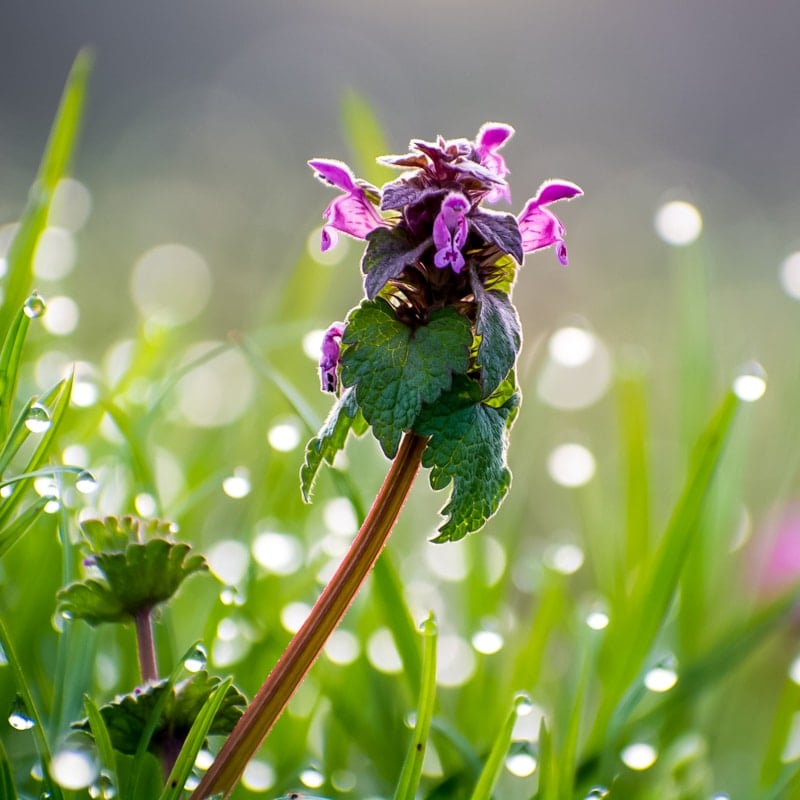
Purple Dead Nettle Look-alikes
Purple dead nettle does not have any toxic look-alikes.
It is sometimes confused for henbit (Lamium amplexicaule) which is closely related and another tasty edible weed.
The main difference between purple deadnettle and henbit is the arrangement of the leaves. Henbit has leaves that surround the stem, while purple dead nettle has triangle shaped leaves.
You can see the difference between purple deadnettle (left) and henbit (right) in the photo below.
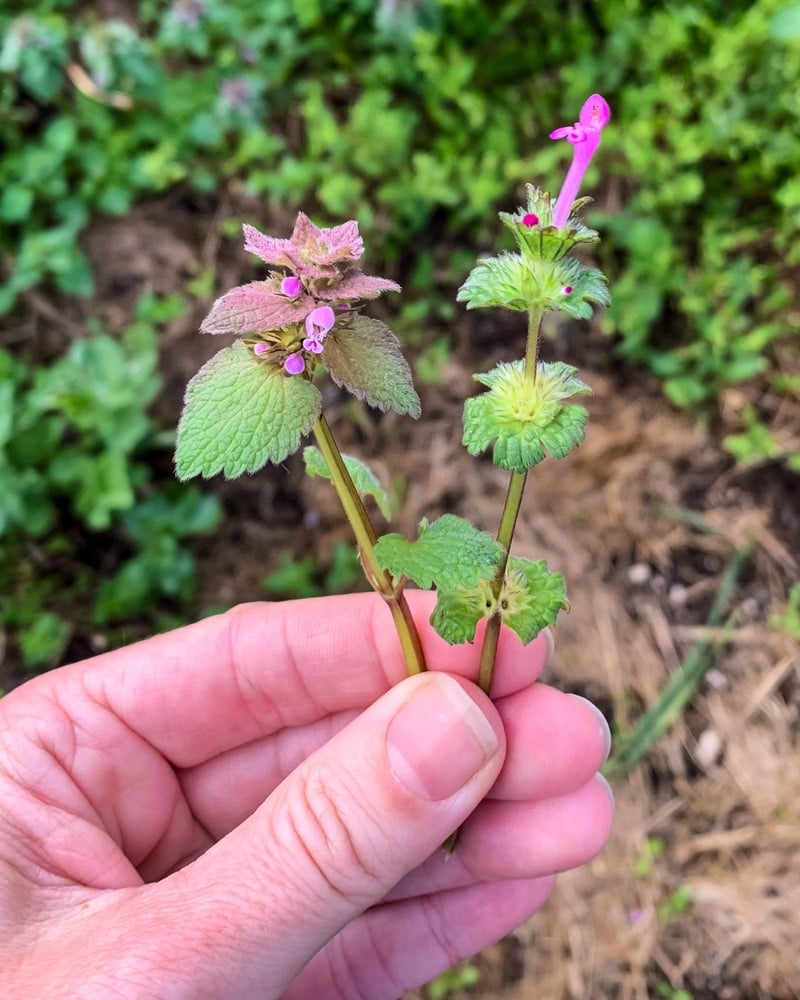
Edible Uses of Purple Dead Nettle
Purple deadnettle is not only a wild edible green, but a highly nutritious superfood. The leaves are edible, with the purple tops being even a little sweet.
Since the leaves are relatively fuzzy, they are better used as an herb garnish or mixed with other greens in recipes, rather than being the star of the show.
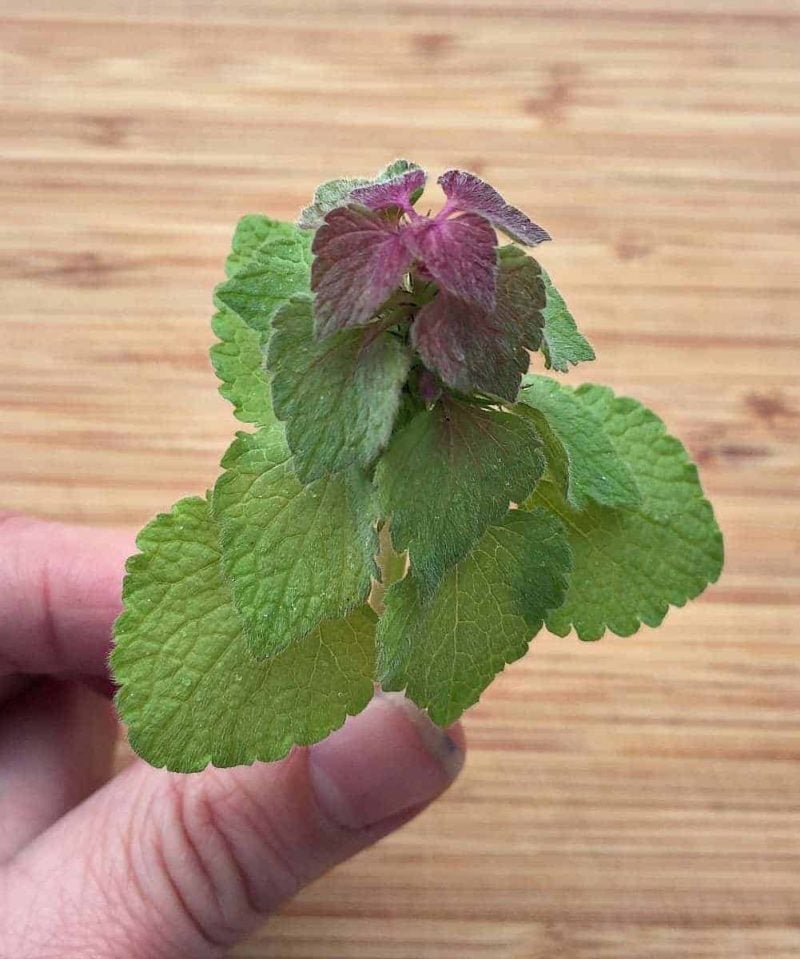
Use fresh dead nettle along with chickweed, dandelion greens, and other backyard weeds to make a wild greens pesto.
Purple deadnettle can also be added to soups, salads, or blended into smoothies. Basically any way that you would use any other green leafy vegetable or herb.
Related: 13 Early Spring Edible Wild Greens
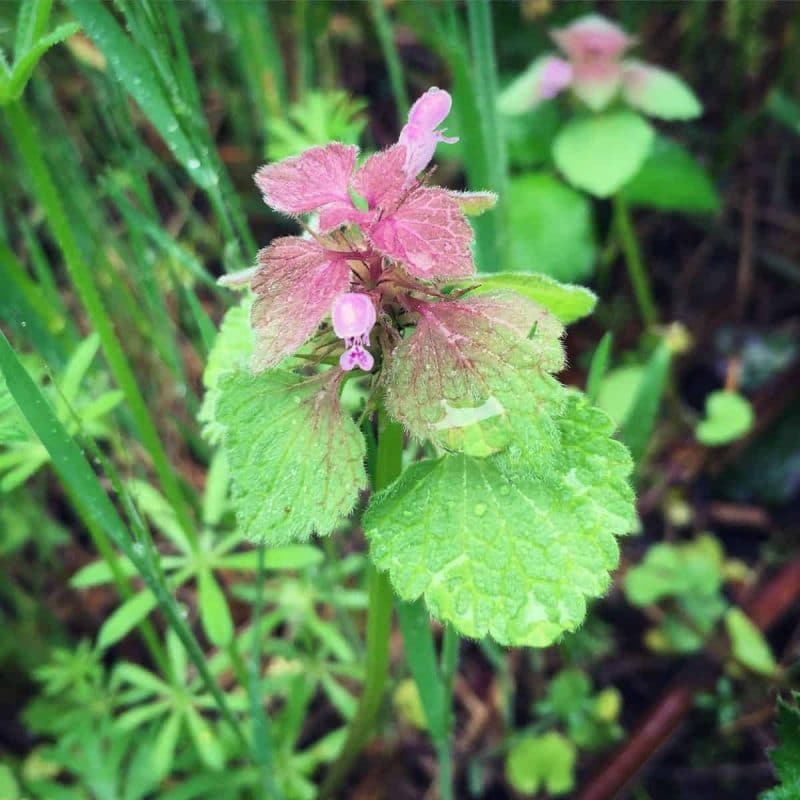
Medicinal Uses of Purple Dead Nettle
In herbal traditions, purple dead nettle has been described as having astringent, diuretic, diaphoretic, and mild laxative properties. It also contains compounds with anti-inflammatory, antibacterial, and antifungal potential, though more research is needed to fully understand its effects.
The leaves have been traditionally applied to minor wounds or cuts, sometimes as a poultice, though scientific evidence on its wound-healing properties is limited. This is similar to how you would use yarrow or plantain.
Purple dead nettle would also make be a good candidate for a homemade herbal salve.
Here is a post for how to make dead nettle salve three ways.
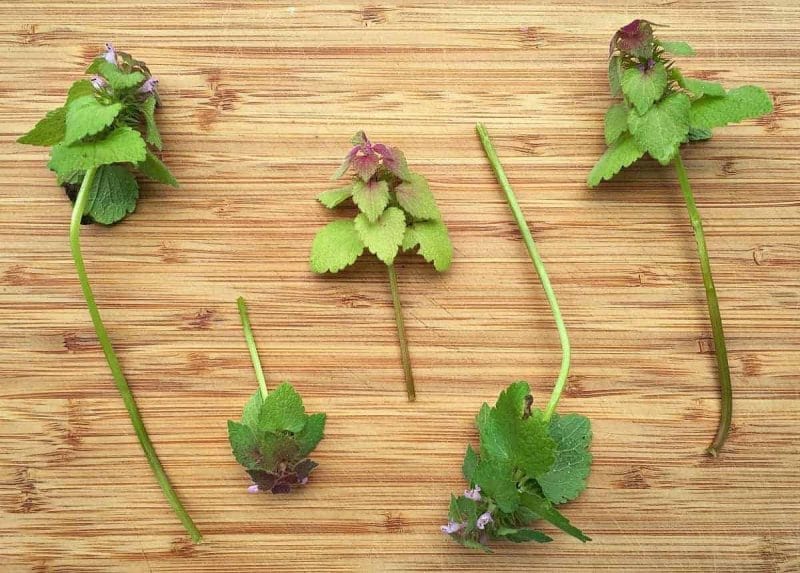
Purple dead nettle can be prepared as an infusion or tea, using either fresh or dried plant material. While some herbalists use it for its potential benefits, consuming it in large amounts may have a mild laxative effect.
It can alternatively be made into a tincture using the same method as this lemon balm tincture.
Some reports suggest it may support kidney function and help with seasonal allergies, but clinical research is still lacking. More studies are needed to confirm its effects on allergies.
Studies suggest that Lamium purpureum (purple dead nettle) contains bioactive compounds, including flavonoids and phenolic acids, that may contribute to its traditional medicinal uses. With the entire genus, Lamium, used in folk medicine for its antispasmodic, astringent, anti-inflammatory, and antiviral properties.
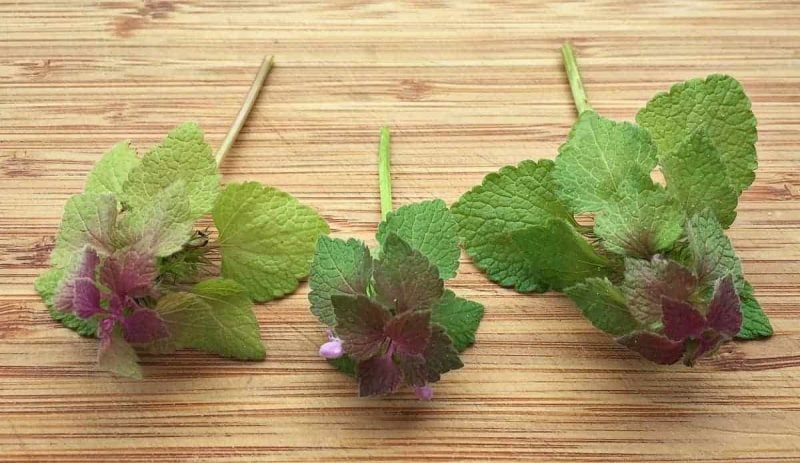
Other Uses for Purple Dead Nettle
Purple dead nettle can be given to chickens as a nutritious food, along with other weeds like henbit and chickweed. I chopped some up and gave it to my young chicks, and they went absolutely bonkers over it!
It is also an important plant species for bees.
Not only do bees seem to prefer it over other plants (even dandelion), but it is one of the first plants to flower in the spring. It may even flower in mild climates through the winter, making it a vital bee forage.
It can even be used to make a natural dye for wool and yarn!
Here are more ideas and recipes for how to use purple dead nettle.
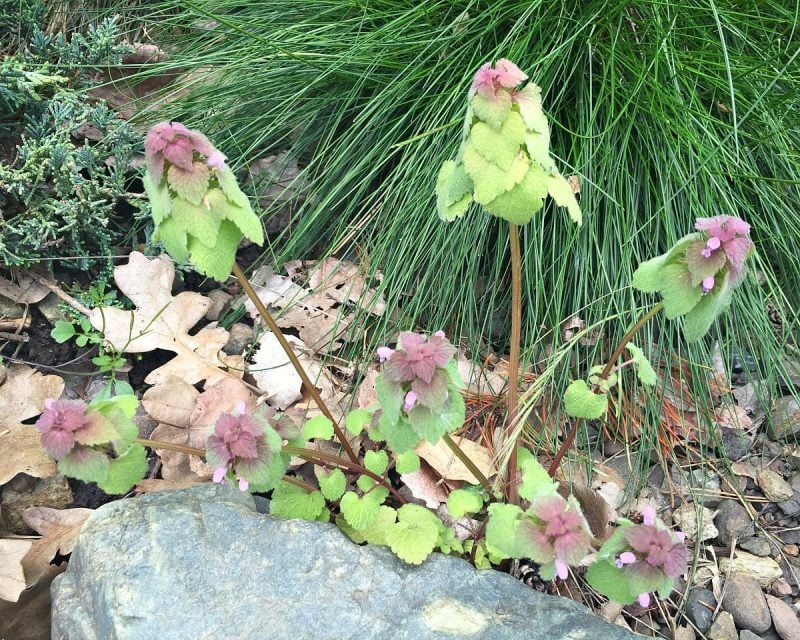
That’s a lot of benefits for one little plant that is often frowned upon! This is what I love about so many “weeds,” they are usually extremely beneficial for us, and easy to find.
I’m going to start picking more purple dead nettle while I can!
Want to learn more about medicinal herbs? Check out The Herbal Academy!
Do you have any purple dead nettle growing near you? Did you know that it was edible and medicinal?
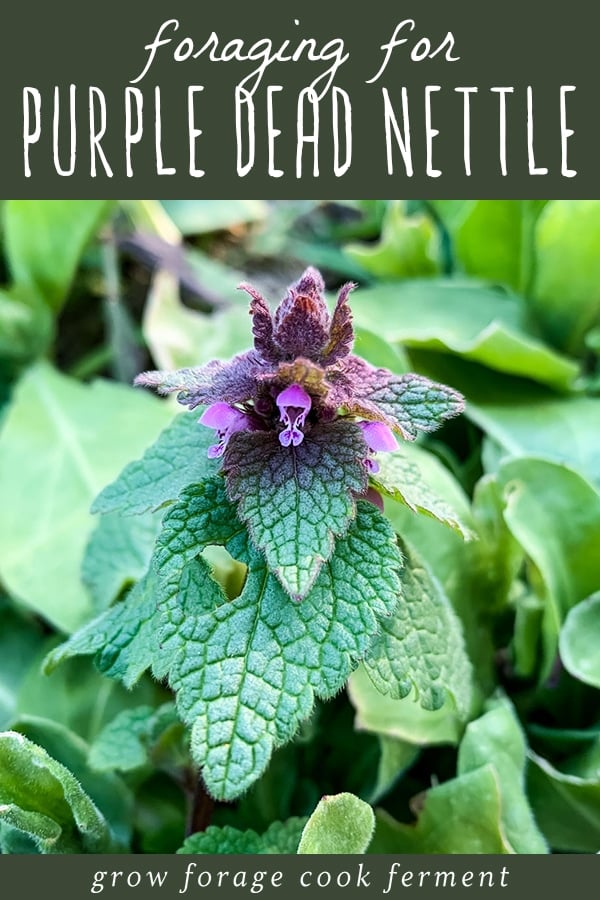

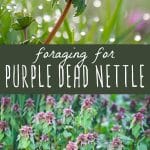
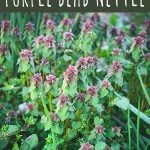
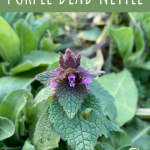
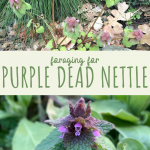
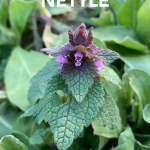

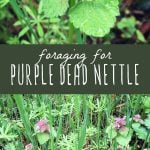
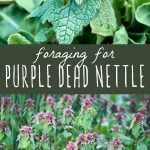

I have purple dead nettle in my backyard growing along my fence. It has already bloomed a couple weeks ago. The top of plant is yellow now but the bottom is green. How long can you harvest this plant?
I may be different, but the taste of dead nettle does not appeal to me at all! is there anything I can do to cover up it’s strong taste?
Hi Paula. Have you tried cooking it or adding it minimally to a salad? Maybe sauteeing it with butter, lemon, and other leafy greens will make it more palatable for you.
If i want to store it to make a salad later, can i do that? Does it brown in the fridge? Is it okay to prewash?
Hi Val. Yes, you can store purple dead nettle in the fridge prewashed until you’re ready to make a salad.
Thank you for the information. Anyone can come and get it at my house. My goodness it has taken over everything. Our yard, in ground and raised bed gardens. All of it. We pull it out and it just comes back. It is pretty though and I might try to use some of it instead of throwing it away.
So happy to learn this has edible and medicinal qualities! We moved to Leaburg, OR and it is abundant along the McKenzie River. All I had ever read prior to your info was that it was a weed. Thank you!
I cook it as a main dish along with red clover. I wish I could show you pics. I mix the two and fry in Imperial spread. You can add a little coconut milk if you like.
Early this year, I showed my teen son the purple dead nettle in our yard and explained that it was edible. He said he wouldn’t eat anything named purple dead nettle. Then later in the month, he came home and said one of his teachers had pointed it out and said it was poison ivy. “What did you do?”
“I ate it. She exploded.”
You never know when weedcraft will come in handy.
Haha, that’s hilarious, Shawna! I’m glad your son was able to teach his teacher something new!
The story at the end…🤣🤣🤣🤣
This made me smile. Thanks for sharing!
Hahaha I love that! Thanks for sharing :)
OMG that was so comical I always ❤️ reading the comments. You just never know, do you
I love foraging. Make sure the wild edibles and medicinal plants you harvest have not been contaminated with pesticides, herbicides or car fume exhaust.
If neighbors have perfect manicured grass lawns they probably use pesticides. If you have acres of wheat, corn, soy, potatoes, etc growing near you, be careful for run off that is sprayed onto those fields.
Try not to pick from next to the road if possible.
Also, wild violets (not stems) and dandelions (whole plant) can be eaten raw or blanched.
Good luck and happy foraging!
I just bought a house on 3 acres and just off my porch I saw this little weed but to me it looked like mint. I pinched off a few leaves to smell it but it didn’t smell like mint. Later I was going to TikTok and found an herbalist talking about dead nettle. I figured that was it so I habe been looking for more about this little plant.
I have this growing all over my yard and finally worked up the courage to try it last night. I approximated a recipe for stinging nettle that Emmymade did (she got the recipe from Cooking Apicius), I didn’t have all the ingredients and had to substitute some of my own. I rinsed and chopped a big bunch of Purple Dead Nettle (recipe called for Stinging Nettle), then in a large pot brought to a simmer several crankings of fresh group pepper, 1 TB orange juice concentrate (recipe called for grape concentrate), 1 1/2 TB fish sauce, 4 TB olive oil. I added my Dead Nettle and cooked it all down, drained it, dumped it in a fry pan, spread it out, beat 4 eggs in a bowl and poured them over the nettles, and cooked it all, pushing it around with a spatula til done. Topped it with grated parmesan cheese, served it with toast. It was very tasty!
That sounds wonderful. Thanks for sharing!
should you be aware of land that might be sprayed with insectisides before you pick and eat these weeds?
Yes. Always forage from unsprayed areas and away from roads.
I apologize for contacting you this way…
No problem in foraging for food in back yard 😁
Husband however concerned about our Goats.
Friends with other livestock told him it was poisonous.. & not listening to me
Is it safe for livestock ..goats in particular? I haven’t come across it in anything I have read… unfortunately he doesn’t believe me
It’s safe for goats.
Did you use the stems too?
Is dead nettle good for adrenal and thyroid issues like stinging nettle?
Hi Ashleigh, sorry I’m not sure about that! I would ask an herbalist or naturopath.
the purple dead nettle got its name from the similar shaped leaves but is actually part of the mint family.
Thanks for a great article!
On our homestead, we are often furiously busy during the early part of Fall, and this year, with an unusual lack of snow on the ground so late in the year, it’s an incentive to be reminded we could pick up some bounty on a jaunt around the wilder parts of our neighborhood.
Regarding the health benefits of herbs, I once worked for a German herbalist and aromatherapist who told me that in the ,Europeans who made a practice of keeping herbs in their diets i survived the onslaught of numerous virulent diseases much better than their urban neighbors.
As my study of holistic health has advanced, I realized that herbs, having not been bred for cultivation, have a much greater tendency to absorb micro-nutrients that have often been stripped from farmed land. As wild food sources, they provide many nutrients our bodies require for optimum health.
Oh, yeah! Get out there, get breathing, engage with the treasures of the soil!
Thanks so much for sharing, Sandy! I completely agree with you.
I live in New England and have a new flower bed I’m cultivating for the first time this year; it’s at the edge of some small woods and I have seen some weeds I’m not familiar with before. They are quite young so no flowers, but look most similar to the purple dead nettle pics you have here. (At first I thought they looked like mint, too–but they don’t have a scent.) However, when I tried to pull them up, they STUNG like stinging nettles I’ve encountered in the UK.
Here’s my question: Do you know, is there some third type of nettle that’s “in between” stinging nettle and purple deadhead, which stings like the one and looks like the other? Or do you suppose the weed in my garden is some sort of cross between the two? Or… Basically, I’m trying to figure out if what we have here is edible, and if so I will treat it differently than just trying to remove it all…
did you ever figure out what you had there? i’ve walked through a field of stinging nettle before i knew what it was… not a pleasant surprise.
You can eat stinging nettle too. If you cook it, the stings loose their potency.
It sounds like slender nettles maybe…a native stinging nettles cousin. Look up urtica gracilis.
I literally just found out about Dead Nettle a little over a month ago. I had seen it and people said ti doesn’t taste like mint even though it looks like one. Then they’d follow that with “It’s just a weed” I’m so glad I found out about it because other than the slight hairiness of it it has a really rich flavor… for a green that is, but not as rich as Lambs-Quarters. Which is my favorite.
This plant is all over the place in my area (Iredell Co., N.C.) and I never thought about eating it because it looked kind of poisonous. I am starting to get really interested in foraging.
I’m in Yadkin county, NC…I have them everywhere in my yard!!
Do you eat the stem and the flower too? I am hoping to add to my smoothie. Also I have read elsewhere that some people blanch it, is this necessary?
Hi Angela, the stem and flower are both edible so you could definitely use them in your smoothie! Dead nettle does not need to be blanched before using, but stinging nettle does.
I dehydrate my stinging nettle then use it as a tea, or herb kin winter soups.
❤︎Have bunch that popped up in my yard over in Chicago! Thanks for all the info.❤︎
Same! My beds are full of it this year. Last year’s random weed takeover was the magentaspreen lambsquarters. This is the year of purple deadnettle.
Same! I’m in VA and they grow in huge bunches all around my house, along with dandelions and wild strawberries.
If you take a petal and suck on the white part, you can taste a bit of nectar. It’s very tasty.
You mentioned it has benefits for your kidneys.
Can you share some recipes and tell me some ways to use it for this benefit?
Hi, Thank you for your wonderful work and sharing your knowledge! I have seen this plant (purple dead nettle) everywhere, all of my life throughout Southern and Coastal NJ, where I live. Funny enough yesterday I was in the backyard and said out loud, this has to be edible. Then later last night I saw a friend had posted your post. I have a Peterson’s Field guide and I wonder if this is also called woundwort? As far as I can tell, the writer Lee Allen Peterson identified it as woundwort in the nettle section of the book. You describe it as mint-like and having many properties of mint. Many if those arealso cooling and at times purgative. Did you feel that reaction upon eating it? I know pennyroyal has emaguge and purgative and is related to mkntis this a similar use for this? Thank you so much! I am going to subscribe!
Sorry for typos! Cracked phone screen
Hi Rita! Good to see you here! I just found some purple dead nettle round my neighborhood and this site helped me accurately distinguish it from henbit! I thought it was in the mint family and edible too when I saw it, but didn’t know what kind. So good to see you here!
I’m trying some healthy and more natural ways so picked some and ate a little and made a tea which I don’t know who said it had a grassy or mint flavor as it definitly tasted more like beets which some may love but reminds me of dirt. I did drink my cup and picked plenty of dandelions which made a delicious salad!
As my property is a pollinator location, I’m leaving mine for the bees along with other mints and other plants. We have plenty of sustenance for ourselves, thanks to pesticides. They increasingly do not, thanks to pesticides.
Would love to know the recipe for a salve, and what is the recommended % of Tincture? Also, drying some now, are the stems ok to use in my powdered Purple Dead Nettle?
Here’s the salve recipe….https://www.growforagecookferment.com/how-to-make-an-herbal-salve/#wprm-recipe-container-5315
I tinctured dead nettle with glycerine last spring and found it is surprisingly the best thing I’ve ever had for relieving allergies, runny noses and congestion. I ran out this year and have patiently waited for it to come up again. Got some in a jar right now. Will collect much more this year.
How did you use it to help allergies? Sublingually? Diffused? Tea?
Can you tell me how you made the glycerin tincture with the dead nettle?
Please can you say how this was done, it is growing in abundance right now in my garden area and yard. So happy to find out there is a wonderful use. Please tell me can I dry this herb/weed? Also, may I use the flowers and stems? I want to gather as much and preserve as much as possible so it can be used and shared. My feeling is we don’t know if it will help with the “new germ” but my gut says YES, and that is why there is so very much this Spring for foraging, a gift from God and nature. Thank you so very much for the pictures and for all that you do to help everyone.
I had the exact same feeling today about the Purple dead nettle being important with the new health crisis. I never knew anything about this plant until I looked it up an hour ago. I wish we could talk about it!
I feel the same way. Earlier this week I noticed for the first time what a profusion of wild violets we have on our 5 acres. I was overwhelmed with gratitude. Today I want to confirm that what we have is dead nettle. I love this site and the community around it.
Yes! I have lived in my house for 3 years and have never seen this plant until this year. It is abundant. Gift for sure!
Thank you for the idea! You would think that local plants would help best with local allergies. Crossing fingers :) I’ll put the fresh herb into a cup jar, crush slightly and fill the jar with glycerine without water. Is that how you did it approximately? It’s my understanding, if using dry material, extra water is added, if the plant material is fresh, glycerine alone is fine.
Thank you! By the way to you all–any plant rich in quercetin is going to be important now. Garlic, red onion, red lettuce, leek and chives, arugula, fennel leaf, lovage leaf… dandelion root… More ideas info?
Ton of it in my new yard! What is the recipe for the salve!!
Here’s the salve recipe….https://www.growforagecookferment.com/how-to-make-an-herbal-salve/#wprm-recipe-container-5315
I grew up calling mother of tyne
This is one of my favorite “weeds”. I have lots of it growing at my house and other locations where I work. It’s one of my favorite photographic subjects :) I live on Orcas Island between Bellingham WA and Victoria BC. It’s one of the true joys of spring !!!
What’s a recipe for salve
I see this weed everywhere. I didn’t know it was. Such a wonderful plant.I picked some in my yard and am going to make salve with it. Thank you.
I had this growing around my house also. I searched for the name and uses without getting results. I was so happy to see this today. I had some saved in old Burma Shave jars b/c it looked so nice dried.
Am sure it’s easy to dig up and replant any where you’d like it to grow. Probably not huge roots.
Such a great little plant w so many uses.
Good luck.
Live in middle Tennessee and my yard is covered in this little gem of a plant! I’ve been noticing the bees are out now and they too are covering my yard! I only wish this was growing on the other side where we don’t spend so much time, as this will all be cut down in a few weeks. Is there an easy way to propagate it or transplant? And how should I go about drying some? Is there a link for the salve recipe?
How can you make salve out of this purple dead nettle.
Try using a recipe for Calendula salve, replacing the Calendula with the purple nettle.
Hi, I am in West TN and this year have an abundance of this plant, purple deadnettle and I too was thrilled to find so many uses and believe in my heart that it will have a benefit in the current health crisis. This belief comes from my native American heart I simply need more information as soon as possible since it is blooming now and wants to be gathered.
As a native person, I wonder if you could comment on how appropriate it would be in your area or among native people in North America in general if would be considerate and important to inquire, especially on land that is acknowledged for use by native people or officially designated as reservation land, about how to ask permission to forage in these areas? Where I am, in a Northern Wetlands area, there are several tribes, (or “bands” being the preferred term) with zones acknowledged for their use for traditional medicinal and food gathering, including waterways whose banks are rich with herbs and food plants that are commonly foraged between cultures. This becomes a very sensitive issue where there are endangered species that may be damaged by unskilled or inattentive foraging practices.
I grew up among native people in a very verdant area, and my Mother taught me to ask permission whenever I stepped off of our property and felt like a snack or found anything I knew would be welcome at home. Later, my native friends suggest that I also ask permission of Mother Nature and sincerely thank her, leaving a gift from my home, if possible, for so freely sharing the abundance she has provided for us all. An of course, to always leave a major portion behind for all of her world to share. Those we ask may not say much, but the request, and the respectful observation of the response will be appreciated.
I propogated it by just picking it as close to the root as I can and then replanting in my balcony. Still alive and thriving adter a month.